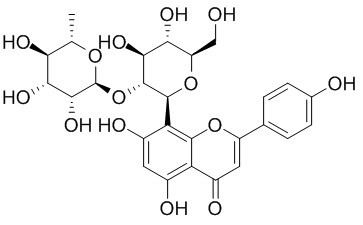Vitexin-2''-O-rhamnoside
Vitexin-2''-O-rhamnoside contributes to the protection against H₂O₂ -mediated oxidative stress damage and could be safely used for a wide range of concentrations.It has low bioavailability, mainly related to its poor absorption in the intestine.
Inquire / Order:
manager@chemfaces.com
Technical Inquiries:
service@chemfaces.com
Tel:
+86-27-84237783
Fax:
+86-27-84254680
Address:
1 Building, No. 83, CheCheng Rd., Wuhan Economic and Technological Development Zone, Wuhan, Hubei 430056, PRC
Providing storage is as stated on the product vial and the vial is kept tightly sealed, the product can be stored for up to
24 months(2-8C).
Wherever possible, you should prepare and use solutions on the same day. However, if you need to make up stock solutions in advance, we recommend that you store the solution as aliquots in tightly sealed vials at -20C. Generally, these will be useable for up to two weeks. Before use, and prior to opening the vial we recommend that you allow your product to equilibrate to room temperature for at least 1 hour.
Need more advice on solubility, usage and handling? Please email to: service@chemfaces.com
The packaging of the product may have turned upside down during transportation, resulting in the natural compounds adhering to the neck or cap of the vial. take the vial out of its packaging and gently shake to let the compounds fall to the bottom of the vial. for liquid products, centrifuge at 200-500 RPM to gather the liquid at the bottom of the vial. try to avoid loss or contamination during handling.
Int J Mol Sci.2024, 25(5):2914.
Fitoterapia.2015, 100:179-86
Heliyon.2024, 10(7):e28364.
Cell Mol Biol (Noisy-le-grand).2023, 69(15):167-173.
Int J Biol Macromol.2020, 161:1230-1239.
J Med Assoc Thai2024, P-04.
Chinese Journal of Tissue Engineering Research2024, 28(8):1149-1154.
Sichuan Agricultural University2023, 4630743.
An Acad Bras Cienc.2023, 95(3):e20220672
J Ethnopharmacol.2020, 260:112988.
Related and Featured Products
J Pharm Pharmacol. 2014 Jul;66(7):988-97.
Effects of vitexin-2"-O-rhamnoside and vitexin-4"-O-glucoside on growth and oxidative stress-induced cell apoptosis of human adipose-derived stem cells.[Pubmed:
24533889]
Vitexin-2''-O-rhamnoside(VOR) and vitexin-4"-O-glucoside (VOG) are the two main flavonoid glycosides of the leaves of Cratagus pinnatifida Bge. var. major N. E. Br. that has been widely used for the treatment of cardiovascular system diseases. In this study, we simultaneously investigated the influence of Vitexin-2''-O-rhamnoside and VOG on human adipose-derived stem cells (hADSCs) injury induced by hydrogen peroxide (H2 O2 ) to further characterize their anti-oxidative and anti-apoptotic activity.
METHODS AND RESULTS:
hADSCs were isolated, cultured in vitro and pretreated with 62.5 μm Vitexin-2''-O-rhamnoside or 120 μm VOG for 24 h and then exposed to 500 μm H2 O2 for an additional 4 h.Pretreatment of hADSCs with Vitexin-2''-O-rhamnoside and VOG was demonstrated to significantly ameliorate the toxicity and apoptosis effects, such as morphological distortion, nuclear condensation, decreased intracellular caspase-3 activity and percentage of cells in apoptosis/necrosis by using morphological assay, immunocytochemistry and flow cytometric evaluation. In addition, Vitexin-2''-O-rhamnoside and VOG caused no cytotoxic effect on hADSCs at concentrations up to 250 and 480 μm, respectively.
CONCLUSIONS:
Our results indicated that both Vitexin-2''-O-rhamnoside and VOG contribute to the protection against H2 O2 -mediated oxidative stress damage and could be safely used for a wide range of concentrations.
Biomed Chromatogr. 2015 May 29.
Hepatic, gastric and intestinal first-pass effects of vitexin-2″-O-rhamnoside in rats by ultra-high performance liquid chromatography.[Pubmed:
26031900 ]
Previous research in our laboratory found that the absolute bioavailability of Vitexin-2''-O-rhamnoside (VR) was quite low at 4.89%.
METHODS AND RESULTS:
A rapid and sensitive UHPLC method using hesperidin as an internal standard was therefore developed and validated to investigate the reasons for this by determining VR in rat plasma after administering intravenously, intraportally (5 mg/kg), intraduodenally and intragastrically (40 mg/kg) to the rat model of the hepatic, gastric and intestinal first-pass effects. As only a high intestinal first-pass effect of VR was found, that is, there existed a low bioavailability of VR (2.40%), inhibitors of P-glycoprotein (P-gp) and cytochrome P450 3A (CYP3A), including verapamil, cyclosporin A and midazolam, and absorption enhancers, including bile salts and borneol, combined with VR, were instilled into duodenum to evaluate the effects on bioavailability of VR.
CONCLUSIONS:
The results demonstrated that area under the concentration-time curve (AUC) values of VR slightly increased after administration of verapamil, cyclosporin A and midazolam, indicating that CYP3A and P-gp do not play an important role in the first-pass effect in the intestine. AUC values of VR significantly increased after administering bile salts or borneol, indicating that the low bioavailability of VR was mainly related to its poor absorption in the intestine.
J Chromatogr B Analyt Technol Biomed Life Sci. 2010 Jul 1;878(21):1837-44.
Simultaneous determination of vitexin-4''-O-glucoside, vitexin-2''-O-rhamnoside, rutin and vitexin from hawthorn leaves flavonoids in rat plasma by UPLC-ESI-MS/MS.[Pubmed:
20570577]
METHODS AND RESULTS:
A sensitive and accurate ultra-performance liquid chromatography electrospray ionization tandem mass spectrometry (UPLC-ESI-MS/MS) method was developed and validated for the simultaneous determination of vitexin-4''-O-glucoside (VGL), Vitexin-2''-O-rhamnoside (VRH), rutin (RUT) and vitexin (VIT) in rat plasma after intravenous administration of hawthorn leaves flavonoids (HLF). Following protein precipitation by methanol, the analytes were separated on an ACQUITY UPLC BEH C(18) column packed with 1.7 microm particles by gradient elution using a mobile phase composed of acetonitrile and water (containing 0.1% formic acid) at a flow rate of 0.20 mL/min. The analytes and diphenhydramine (internal standard, IS) were detected in the multiple reaction monitoring (MRM) mode by means of an electrospray ionization (ESI) interface (m/z 292.96 for vitexin-4''-O-glucoside, m/z 293.10 for Vitexin-2''-O-rhamnoside, m/z 299.92 for rutin, m/z 310.94 for vitexin and m/z 166.96 for IS).
The calibration curve was linear over the range 10-40,000 ng/mL for vitexin-4''-O-glucoside, 10-50,000 ng/mL for Vitexin-2''-O-rhamnoside, 8-1000 ng/mL for rutin and 16-2000 ng/mL for vitexin.



